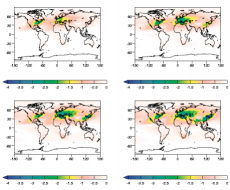LLNL Scientists Use NERSC to Advance “Aerosol Initiative
August 1, 2004
While “greenhouse gases” have been the focus of climate change research for a number of years, DOE’s “Aerosol Initiative” is now focusing on how aerosol emissions affect the climate on both a global and regional scale.
Scientists in the Atmospheric Science Division at Lawrence Livermore National Laboratory are using NERSC’s IBM supercomputer to create simulations showing the historic effects of aerosol emissions at a finer spatial resolution than ever done before. Simulations were carried out for five decades, from the 1950s through the 1990s.
The results clearly show the effects of the changing global pattern of aerosol emissions. Whereas in 1950 the United States emitted 41 percent of the world’s aerosols, this figure had dropped to 15 percent by 1990, due to conservation and anti-pollution policies. By contrast, Asian emissions jumped sixfold during the same time, from 7 percent in 1950 to 44 percent in 1990.
Under a special allocation of computing time provided by the Office of Science, Dan Bergmann was able to push through a large number of calculations during the past month, making the aerosol project one of the largest users of NERSC resources. The applications typically ran on 160 processors.
The objective was to assess the different effects of man-made aerosols. The aerosols are emitted as a gas, then turn into particles known as sulfate aerosols. These particles have a short lifespan in the atmosphere, often washing out in about a week. This means that their effects on climate tend to be more regional, occurring in the area where the emissions occur.
To accurately study these regional effects, Bergmann needed to run the simulations at a finer scale, as the coarser resolution (typically 300km by 300km) of other climate models are insufficient for studying changes on a regional scale. Livermore’s high-resolution climate model allows a 50km by 50km grid to be applied. NERSC’s terascale computing capability provided the needed computational horsepower to run the application at the finer level.
Depending on their composition, aerosols can either scatter or absorb sunlight, thereby cooling the Earth and acting as a counter to the warming effects of greenhouse gases. Greenhouse gases such as carbon dioxide are much more longer-lived, so they stay in the atmosphere and have more uniform distribution. But since global warming has not increased as much as some computer models predict, scientists have become more interested in aerosols as and their possible role in countering some effects of greenhouse gases.
“The atmospheric concentrations of both aerosols and greenhouse gases have increased over the past century and, because of their effects on shortwave and longwave radiation (which are partially offsetting), have presumably upset to some degree the thermal equilibrium of the climate system,” the group wrote in their proposal to DOE. “While satellite measurements and field studies provide vital information to document the global and regional climate impacts by aerosols and greenhouse gases, accurate climate model simulations are likely the best approach to quantify the radiative forcing as well as to identify and analyze the climate response.”
By running numerous calculations at finer resolution, the team was able to see the cooling effects by region, and to see more differences in the effects of varying concentrations.
The simulations also gave the team an opportunity to test new meteorological data generated using LLNL’s version of NCAR’s CCM3 (Community Climate Model). This model couples the various factors influencing climate, such as winds, temperatures and precipitation. This data, which bordered on the terabyte scale, was also generated at NERSC.
The LLNL researchers then used the climate data to drive their chemistry model known as IMPACT. By varying the emissions levels while running IMPACT, the team was able to simulate different scenarios for each decade and see where the aerosols went and their effects on the climate.
The results of the LLNL runs at NERSC will be form the basis of proposed additional research under the Aerosol Initiative launched by the Office of Biological and Environmental Research in DOE’s Office of Science.
About NERSC and Berkeley Lab
The National Energy Research Scientific Computing Center (NERSC) is a U.S. Department of Energy Office of Science User Facility that serves as the primary high performance computing center for scientific research sponsored by the Office of Science. Located at Lawrence Berkeley National Laboratory, NERSC serves almost 10,000 scientists at national laboratories and universities researching a wide range of problems in climate, fusion energy, materials science, physics, chemistry, computational biology, and other disciplines. Berkeley Lab is a DOE national laboratory located in Berkeley, California. It conducts unclassified scientific research and is managed by the University of California for the U.S. Department of Energy. »Learn more about computing sciences at Berkeley Lab.








